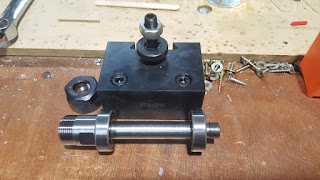During the Hilux ute tray build I was experimenting with aluminium honeycomb panelling for ease of assembly. I have used it at university in the FSAE race car team.
Here was some practice CNC Routing and bending pieces.
CNC routing a Western Red Cedar centreboard core for a carbon fibre centreboard on a sailing dinghy
Prototype front panels for electrical systems made on the CNC router from 4 mm aluminium plate.
Prototype parts from 12mm Aluminium plate on the CNC router.
Making a Drilling & Milling attachment for the lathe tool post. Using a COTS ER20 collet chuck with 16mm straight shank 150mm long. The shaft was turned down for bearings and a standard boring bar quickchange tool post holder was bored out to accept the deep groove ball bearings. Note: I expected these ball bearings to not provide enough rigidity to the setup, but have been very happy with the results.
Showing bearing assembly. One the right hand side a shaft for the drill was pressed into the bore a secure with Loctite retaining compound.
Next step was to make an indexing plate and shaft lock for the spindle of the lathe.
Spindle locking mechanism based on a "dynabolt" type wedging action inside the spindle bore.
First indexing plate made from 10mm thick HDPE. It works very well, when I run into rigidity problems i'll upgrade the design to a 4-6mm aluminium plate.
Drill can now be used at any angle with the compound slide and the chuck can be indexed.
First test piece.
Pretty happy with that.
Next job, small boring bar holder to hold small carbide end mills as boring bars.
Completed assembly.
New Geeetech Aluminium i3 ProB 3D printer. I've been using adative manufacturing at work for years, but it was time to start playing with alternative materials and designs at home.
Out of the box there were plenty of issues ($250 kit printer is certainly the bottom end of the market).
I designed a new belt and bearing system for the Z-axis so they could be driven of a single more powerful Z-axis motor. This ment that both leadscrews would always be synchronised and couldn't "rack" relative to each other.
Practising my internal and external thread making on the metal lathe.
Building a DIY strip heater for bending plastics. Using basic hardware store parts and a variable lab power supply. The CNC router took care of the shape and profile.
Very happy with the first attempt.
CNC Routing steel
The first attempt didn't go so well...
With a bit of tuning I found the following was okay:
Tool - 1/8" single flute solid carbide
Spindle = 12,000 rpm
Feed = 600 mm/min
DOC = 0.2 mm per pass
Slow going, but okay for small parts.
I tried an experimental technique for folding sheet metal parts. How could I use a CNC router for part accuracy and still fold metal parts in the home shop without a press brake? This seems like a viable solution. If strength is needed, the folds could be welded up or braced internally.






























































